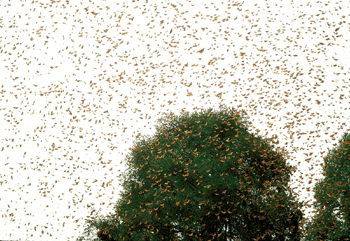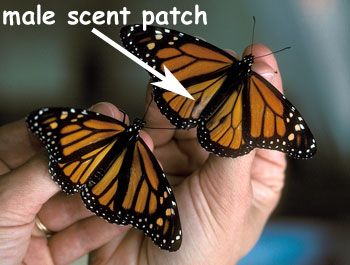Background for Teachers
Mysterious Monarchs
TPW Magazine, October 2009
If you don't have a copy of the TPW magazine, you may print a copy of Mysterious Monarchs (pdf).
Each autumn as days shorten and temperatures drop, a number of natural events occur in plants and animals. Trees turn gold and crimson. Ducks, geese, and other species of migratory birds begin to move out of the north into areas of more abundant food. Many insects spend the winter as eggs or larvae and dehydrate themselves to keep from freezing. But, one unique insect has a different survival strategy - the Monarch Butterfly.
Like migratory birds, monarch butterflies (Danaus plexippus) have evolved the ability to fly long distances, escaping winter cold and the absence of food. Decreasing day length and cooler temperatures tell monarchs that emerge in the early fall not to breed. Instead they begin the immense journey across North America, over unfamiliar terrain, funneling through Texas, to nine high mountain sites in fir forests of Central Mexico. They arrive at the overwintering areas by November, remaining there until March of the following spring. Then they return to Texas and the southern United States to lay eggs on freshly sprouted milkweeds. By late spring most from this spring generation have left the Gulf coastal states and are breeding further north. By the beginning of June they have reached the northern U.S. and Canada where they continue to breed all summer.
Texas is an important state in monarch migration because it is situated between the principal breeding grounds in the north and the overwintering areas in Mexico. Monarchs funnel through Texas both in the fall and the spring. During the fall, monarchs use two principal flyways. One traverses Texas in a 300-mile wide path stretching from Wichita Falls to Eagle Pass. Monarchs enter the Texas portion of this flyway during the last days of September. By the third week of October, most have passed through into Mexico.
The second flyway is situated along the Texas coast and lasts roughly from the third week of October to the middle of November. In selected locations, monarchs may be seen in migration in the tens of thousands. Look for the largest numbers during the second and third weeks of October in West-Central Texas, from San Angelo to Bracketville to Eagle Pass. Texas parks in this zone are especially good places to find monarchs. Many locations along the Devils, Llano, Frio, and Sabinal Rivers are also good. Call ahead to parks in the area to see if the monarchs have arrived. If monarchs are there, you must move quickly. They will stay in an area in hot, moist weather with southerly winds, but will leave immediately with a passing front.
Life History
Monarchs are the only butterflies known to make long distance migrations. They are members of a tropical family that cannot survive cold winters. North American monarchs migrate south in the fall to California, Mexico or Florida. On the way north in the spring they lay eggs. It's the young produced by those and the next generation's eggs that return all the way north and start south again.
Monarchs lay their eggs on milkweed plants. Female monarchs can lay between 400 and 600 eggs. Their caterpillars absorb the poisons produced by the plant and become poisonous themselves. Birds that try to eat monarchs or their caterpillars become ill. They quickly learn that monarchs are not good to eat. Other butterflies, such as Queens and Viceroys, copy the colors of monarchs so that birds won't eat them either.
Adults feed on flower nectar. Caterpillars feed on plant leaves, preferring milkweeds and dogbanes. Monarchs enter Texas in the fall weighing 400 milligrams but leave weighing 650 milligrams. This 62.5% increase in weight is stored in the form of fat which the butterflies will use as an energy source during cold weather.
Adult monarch butterflies are orange above with black veins and white spotted wing borders. Males have a black scent patch on a vein across the middle of the hind wing.
Monarchs return by the tens or hundreds of thousands to the same groves of trees each winter. They are sluggish during the winter and feed only on warm days. Humans are trying to protect these important places by creating butterfly preserves. Researchers study monarch migration by tagging individual butterflies to see where, how far and how fast they travel.
Habitat
Monarchs occur wherever milkweeds grow.
Distribution
Monarchs are found all over Texas, the U.S., southern Canada and Mexico to central America. There are also breeding populations in Hawaii and Australia.


